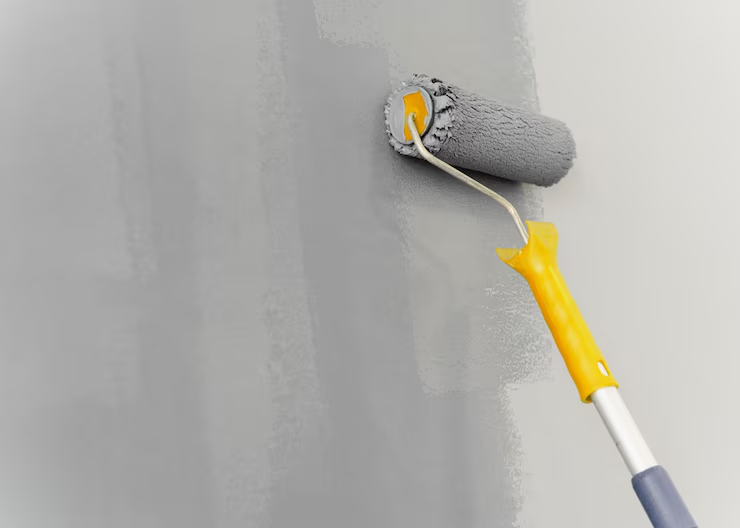Choosing the Best Cement Wall Paint
- Staff Desk
- May 14
- 6 min read
Updated: Jul 30
This post contains sponsored content, affiliate links, and or paid guest contributions. We value transparency and strive to follow FTC guidelines.

Cement wall paint is specially formulated to adhere to the unique surface of cement. Unlike regular wall paint, it must be able to withstand moisture, resist mold, and adhere strongly to a rough texture. This makes choosing the right paint essential for both protective and decorative purposes.
Adhesion to Cement Surfaces
Cement surfaces are notoriously rough and porous, which can present a challenge for standard paints. Cement wall paint is designed to bond strongly with these surfaces, ensuring that it doesn't chip or peel. This strong adhesion is crucial for maintaining the aesthetic and protective qualities of the paint over time. When selecting paint, look for options specifically labeled for cement or masonry use to ensure the best results.
Moisture and Mold Resistance
Moisture is a common issue with cement walls, particularly in basements and exterior applications. Cement wall paints are formulated to be moisture-resistant, preventing the growth of mold and mildew. This resistance is essential not only for the longevity of the paint but also for maintaining a healthy environment. Paints with added fungicides can provide extra protection against mold growth in damp areas.
Durability and Longevity
Durability is a key factor when choosing cement wall paint. High-quality paints provide a robust barrier against the elements, helping to prevent water infiltration, UV damage, and temperature fluctuations. This durability ensures that the painted surface will remain attractive and functional for many years. Additionally, some paints offer added features like abrasion resistance, which is ideal for high-traffic areas.
Types of Cement Wall Paint

Selecting the right type of paint is critical to achieving a long-lasting and attractive finish on cement walls. Each type of cement wall paint offers unique properties suited to different applications.
Acrylic Paints
Acrylic paints are water-based and known for their excellent adhesion and flexibility. They're resistant to cracking and peeling, making them ideal for both interior and exterior cement walls. This type of paint is versatile and easy to work with, drying quickly to a durable finish. Acrylic paints are also available in a wide range of colors and finishes, allowing for creative expression while ensuring the protection of the cement surface.
Epoxy Paints
Known for their durability, epoxy paints are often used in garages and basements where heavy use occurs. They provide a tough, chemical-resistant finish, perfect for high-traffic areas. Epoxy paints form a hard, protective layer that withstands wear and tear, making them ideal for floors and areas subject to heavy impact. Additionally, epoxy coatings can resist stains from oils and chemicals, making them a practical choice for utility spaces.
Masonry Paints
Specifically designed for cement and concrete surfaces, masonry paints are often UV and weather-resistant, making them suitable for outdoor applications. These paints are formulated to expand and contract with the surface, preventing cracking and peeling. Masonry paints are highly breathable, allowing moisture to escape from the substrate, which is crucial in preventing damage to the cement underneath. They also offer excellent coverage, ensuring a smooth and uniform finish.
Elastomeric Paints
Elastomeric paints are highly flexible and great for exterior walls. They can stretch and contract with the building, preventing cracks and water damage. This flexibility is particularly beneficial in areas with significant temperature fluctuations, as it helps maintain the integrity of the painted surface. Elastomeric paints are also waterproof, providing a durable barrier against rain and snow, making them an excellent choice for protecting building exteriors.
Choosing the Right Cement Paint Colors

Color choice is a crucial aspect of any painting project. The right color can enhance the mood of a space, complement existing decor, and even affect perceived space size.
Popular Cement Paint Colors
Neutral Tones: Whites, beiges, and grays are timeless and versatile. They create a clean, modern look and can make a space feel larger and more open. Neutral colors are an excellent choice for those seeking a minimalist aesthetic or wishing to highlight other design features in the room. They are also adaptable, easily blending with various styles and color schemes.
Earthy Hues: Browns, terracottas, and greens bring warmth and a natural feel, making them perfect for creating a cozy and inviting atmosphere. These colors work well in spaces where you want to foster a sense of comfort and relaxation. Earthy tones can also help connect indoor spaces with the natural environment, especially in homes with large windows or garden views.
Bold Colors: Deep blues, rich reds, and vibrant yellows can add character and make a statement. They're excellent for feature walls or adding a pop of color. Bold colors are perfect for creating focal points or energizing a space. When used thoughtfully, they can transform a plain wall into an eye-catching piece of art that reflects the homeowner's personality.
Factors Influencing Color Selection
When selecting paint colors, consider the lighting and purpose of the room. Natural light can make colors appear brighter, while artificial light may change the hue. The size of the room can also influence color choice; lighter colors can make a small room feel larger, while darker shades can add coziness to a vast space. Additionally, consider the existing color scheme of furniture and decor to ensure a harmonious look.
Testing and Visualization
Before committing to a color, it's wise to test a small section of the wall to see how it looks in the actual environment. Paint swatches or sample pots can help visualize how a color will appear under different lighting conditions. Taking the time to test colors can prevent costly mistakes and ensure satisfaction with the final result. Visualization tools and apps can also aid in imagining how different colors will look in a space.
Painting Basement Cement Walls

Basements present unique challenges due to their often damp environments. Choosing the right paint can prevent moisture issues and enhance the space's usability.
Preparing the Basement Wall
Clean the Surface: Remove any dirt, dust, or efflorescence (white powdery substance). Use a wire brush or pressure washer for stubborn areas. A clean surface is essential for paint adhesion and preventing future peeling or bubbling. Taking the time to clean thoroughly can significantly impact the quality and longevity of the paint job.
Repair Cracks: Fill in any cracks or holes with a suitable cement patching product. This ensures a smooth surface for painting. Addressing structural issues before painting is crucial, as it prevents further damage and ensures the paint adheres properly. Consistent maintenance of the wall's surface will support the overall integrity of the painted finish.
Dry the Walls: Ensure the walls are completely dry before painting. Moisture can prevent paint from adhering properly. Drying can be expedited with fans or dehumidifiers, especially in basements prone to dampness. It's vital to monitor humidity levels and allow sufficient drying time to avoid issues with paint application.
Applying the Paint
Prime the Surface: Use a masonry primer to ensure better adhesion and a more even finish. This is crucial for basement walls exposed to moisture. A primer creates a uniform base, enhancing paint adhesion and coverage. It also helps seal the surface, offering additional protection against moisture infiltration.
Use the Right Tools: Opt for a roller with a thick nap to get into the texture of the cement. Brushes can be used for edges and corners. Using the appropriate tools ensures that the paint is applied evenly, covering all nooks and crannies. Quality tools can make the painting process more efficient and yield a superior finish.
Apply Even Coats: Two coats are usually sufficient. Allow ample drying time between coats to ensure the paint sets properly. Applying multiple thin coats rather than one thick coat can prevent drips and ensure a more professional-looking finish. Adequate drying time between coats is essential for a durable and attractive paint job.
Seal for Protection: Consider adding a sealant over the paint for added moisture protection, especially in basements. A sealant can extend the life of the paint job by providing an extra layer of defense against humidity and water damage. This step is particularly important in environments where moisture is a consistent concern.
Conclusion
Selecting the right cement wall paint involves understanding your space's requirements and choosing a paint type and color that will enhance and protect your walls. Whether you're transforming a basement or adding character to an exterior wall, the right paint can make all the difference. Remember to prepare your surfaces properly and follow application tips for a professional-looking finish. Happy painting!



Comments